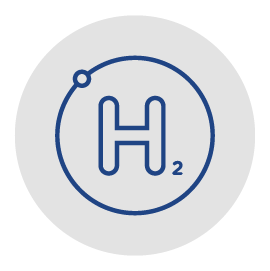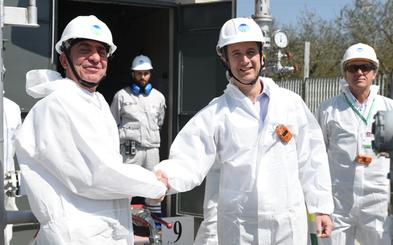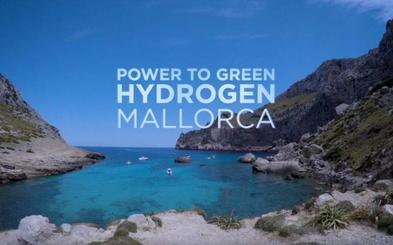INNOVATIVE PROJECTS PLATFORM

Hydrogen
Hydrogen can be produced by various process technologies. Hydrogen can be obtained from natural gas through a steam reforming process or a methane pyrolysis process; produced by splitting water into hydrogen and oxygen via electrolysis or via gasification process, by converting solid fuel (coal or woody biomass) to hydrogen. Hydrogen can also by produced through anaerobic digestion, converting wet biomass to hydrogen. Hydrogen can be utilised directly as fuel or, depending on the application, blended with natural gas.
Hydrogen production from RES-based electricity in power-to-gas facilities or from other fuels in combination with CCS contributes to the decarbonisation of the energy system.
SNAM RETE GAS S.P.A.
Testing of the H2NG supply in Contursi Terme
Snam has launched its experiment of introducing a 5% hydrogen and natural gas blend into the Italian gas transmission network. The experiment, the first of its kind in Europe, is being conducted in Contursi Terme, and involves the supply of H2NG (a blend of hydrogen and gas) to two industrial companies in the area: a pasta factory and a mineral water bottling company.
Contact: dina.lanzi@snam.it
GASUNIE
HyNetherlands
Large-scale production, transport, storage and application of green hydrogen. The Northern Netherlands is a suitable location for a large-scale hydrogen chain because of the presence of green electricity, the good and extensive existing gas network, the gas storage options and the presence of large industrial users of hydrogen. In partnership with ENGIE and EMMTEC.
DESFA, TAP IPCEI
WHITE DRAGON
The objective of the project is to gradually replace the lignite power plants of Western Macedonia and transition to clean energy production and transmission, with the ultimate goal of fully decarbonising Greece's energy system. The "White Dragon" project plans to use large-scale renewable electricity to produce green hydrogen by electrolysis in Western Macedonia. This hydrogen would then be stored and then the transport and export potential of hydrogen through TAP Pipeline connecting Greece to European markets. Partnership with DEPA, Advent Technologies, DAMCO ENERGY, PPC, HEP, MOTOR OIL, TERNA, CORINTH PIPEWORKS.
Gasunie
Magnum power plant
Nuon / Vattenfall, Gasunie New Energy and the Norwegian energy company Equinor are working together on the conversion of the Magnum power station in Eemshaven. It is planned that the first three units of the power plant that are currently still powered by natural gas will be converted to run on hydrogen between 2023-2025. The Magnum power plant will deliver 440 megawatts per unit.
Contact: k.g.wiersma@gasunie.nl
Gasunie
HyTransPort.RTM
The realisation of the hydrogen pipeline within the HyTransPort.RTM project is a key step forward in establishing Rotterdam as a major European hydrogen hub. The pipeline will be constructed between the areas of Maasvlakte and Pernis andwill be an open access pipeline, which means that any company that wishes to consume or supply hydrogen in the area can connect to the pipeline. In the future, the pipeline will also be linked to the national hydrogen grid and other European regions. In partnership with Port of Rotterdam.
Contact Robert Zwakenberg of Gasunie: robert.zwakenberg@gasunie.nl.
GASCADE, Fluxys
doing hydrogen
doing hydrogen is the large-scale pipeline project to kick-start the hydrogen market in eastern Germany, planned to be operational by 2027. The GASCADE-Fluxys project involves a strategic 50-kilometre new-built hydrogen pipeline from the area of Rostock on the Baltic Sea going southwards as part of the eastern German hydrogen grid. This infrastructure will create a powerful hydrogen hub connecting hydrogen production, storage and demand centers.
Enagas
GREEN HYSLAND
A project promoted by the Regional and National Government and some private companies: Cemex, Enagás, Acciona and Redexis. The 10 MW green hydrogen production plant will be powered by a 16 MW solar plant. The project contemplates the use of green hydrogen in mobility, as well as its injection into the gas grid.
Contact: mjaen@enagas.es
GASCADE, Gasunie
AquaVentus
The project portfolio associated with the AquaVentus initiative includes various sub-projects along the value chain from the production of hydrogen in the North Sea to transportation to customers on the mainland. These coordinated projects synchronise demand and production, thereby facilitating market roll-out. In partnership with RWE, Shell, Island of Heligoland, Reuther, Vattenfall, Siemens, Parkwind and MHI Vestas.
GASCADE, Gasunie, Fluxys
AquaDuctus
AquaDuctus is part of the project initiative AquaVentus and aims at transporting green hydrogen, which will be produced offshore in the German North Sea, to the island of Heligoland. At a later stage a connection to the German mainland and to the German national hydrogen network is foreseen. In partnership with RWE and Shell.
Gasunie
NortH2
The consortium has conducted a feasibility study that produced the first results in late 2020. Seeing as these results are positive, the consortium aims to be able to start producing the first hydrogen around 2027.In partnership with Groningen seaport, Shell, Equinor, RWE, Groningen provincial authority, Enico.


